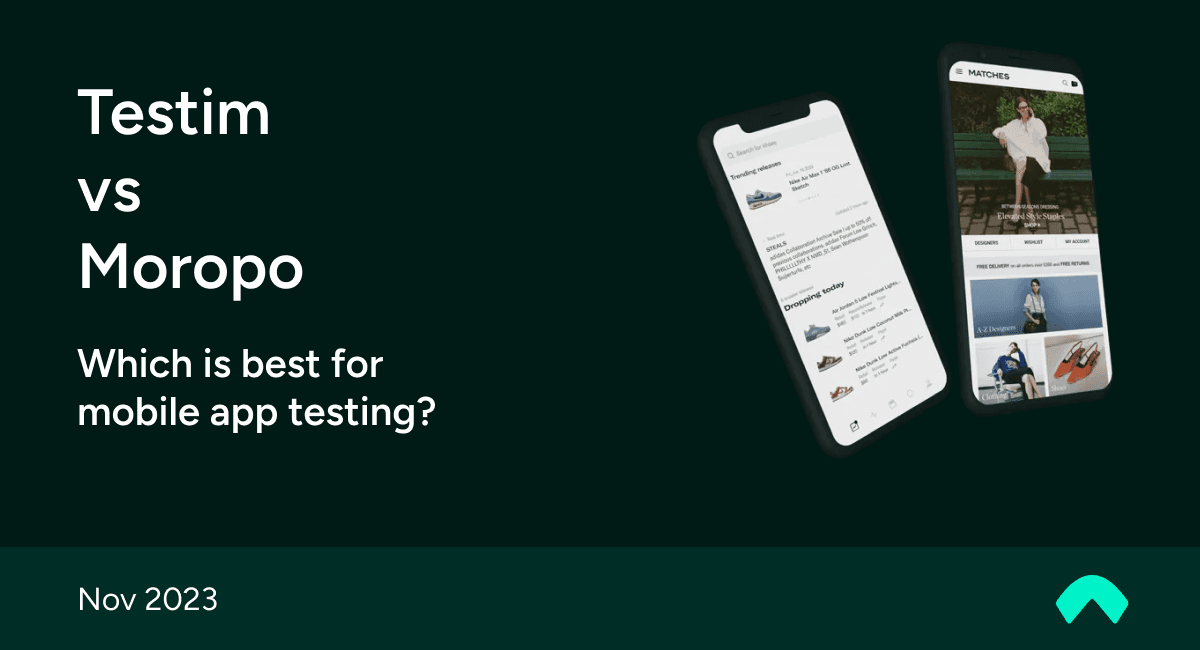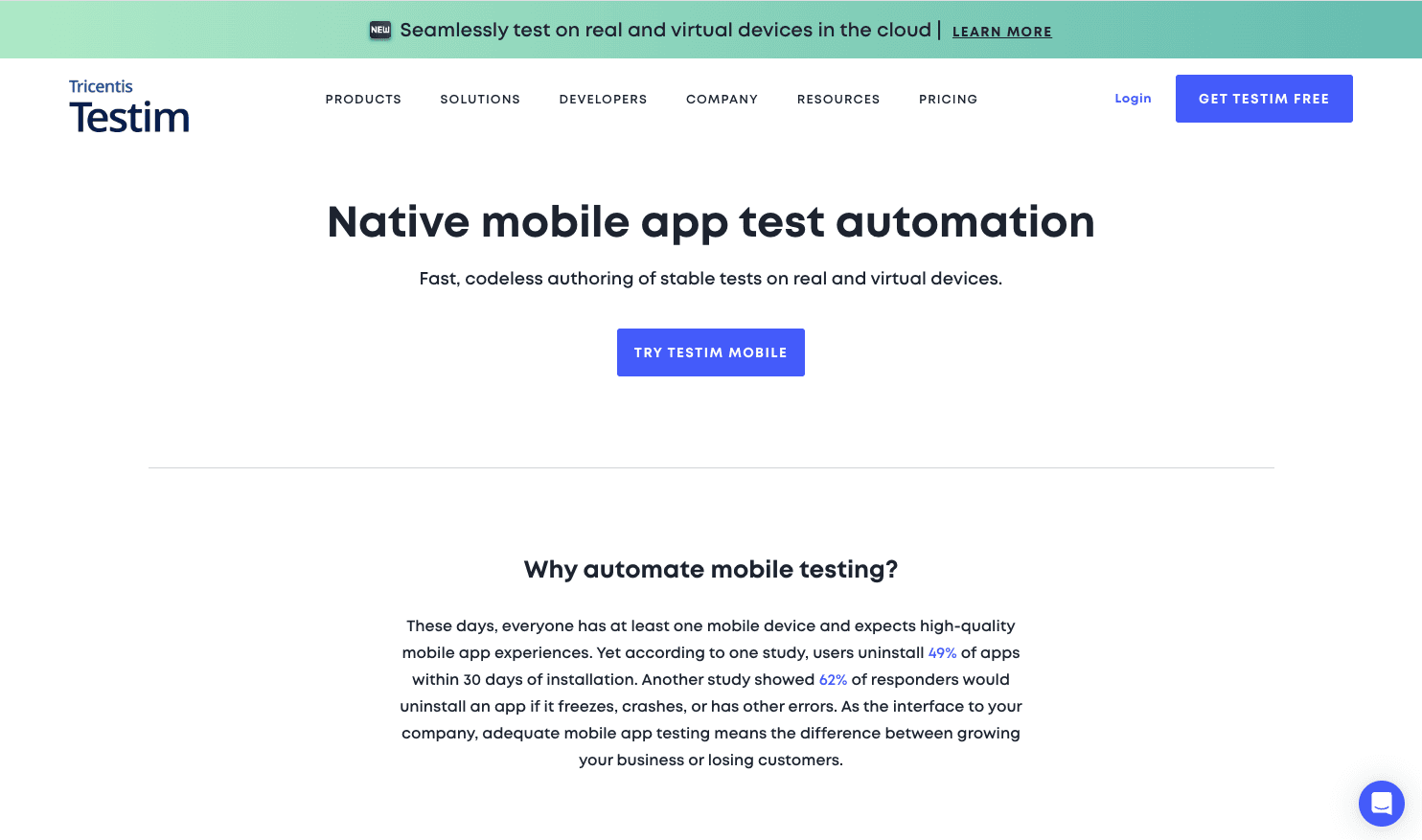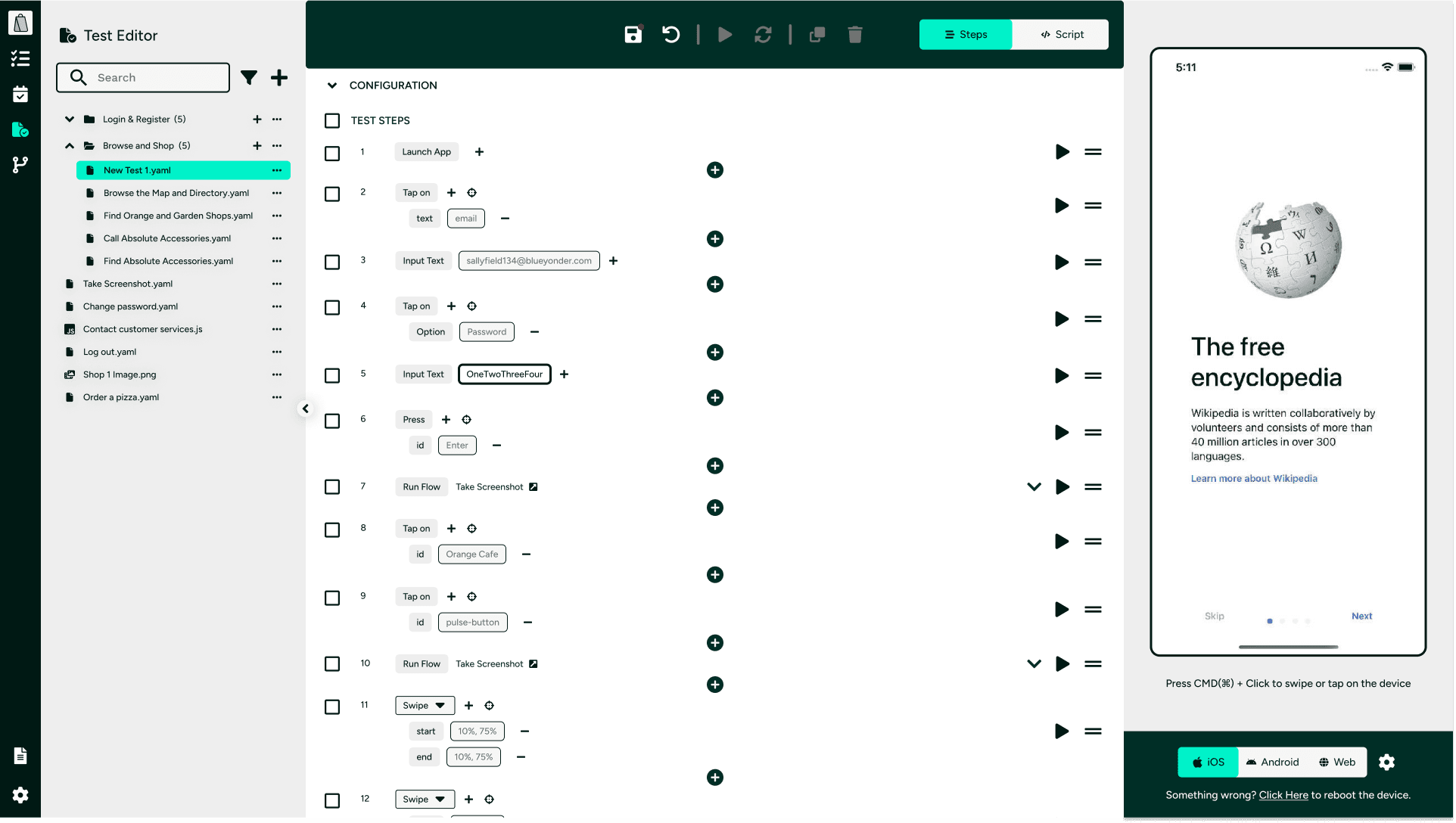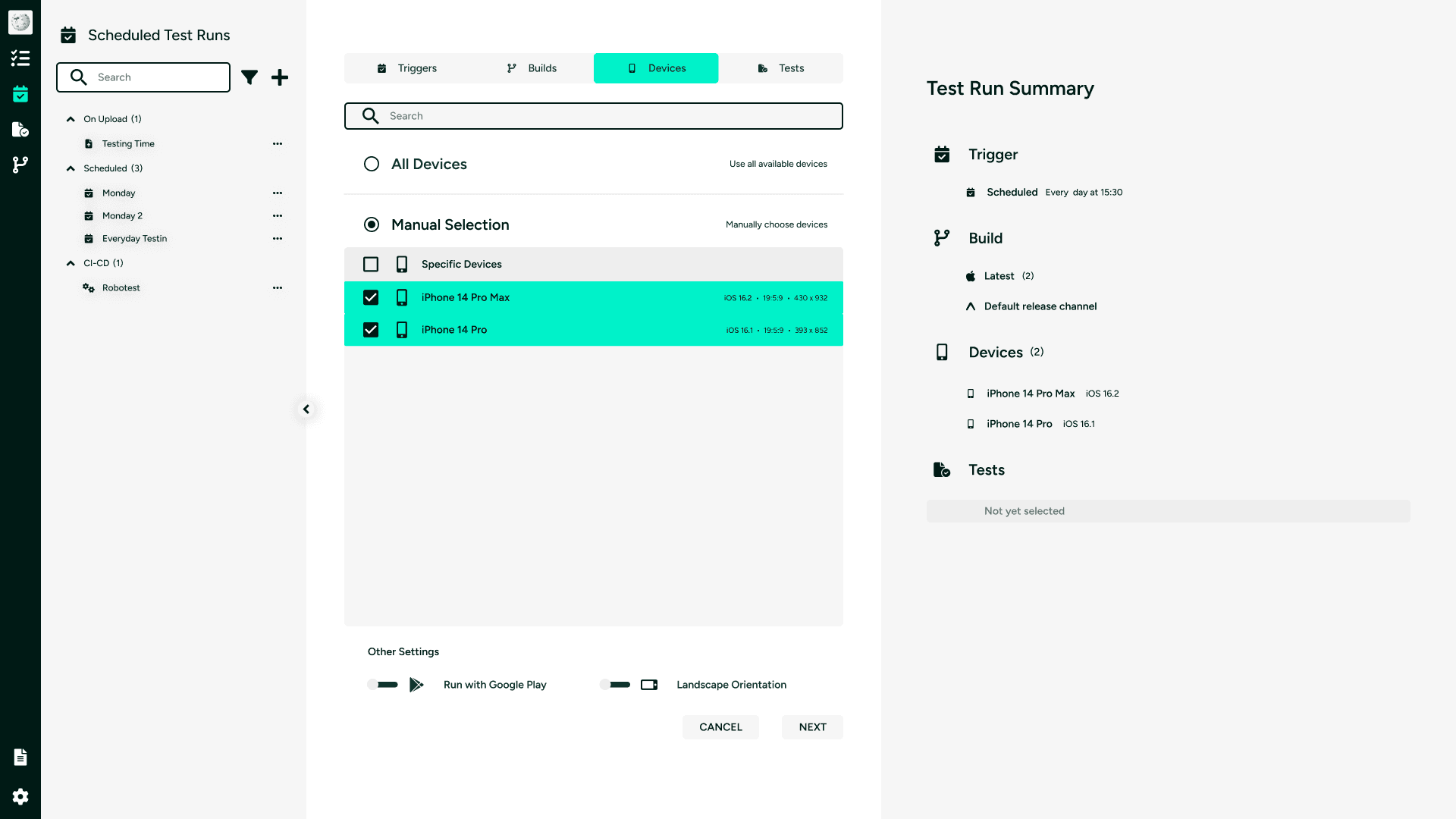Testim Mobile vs Moropo: app testing tool detailed comparison
Dec 5, 2023

Both Testim and Moropo have essential mobile app testing features that will meet the requirements of most QA teams. Yet their pricing, usability, and complexity differences make them better suited for different audiences.
We've compared the tools in five dimensions, all of which are paramount for mobile QA software:
Easy of use
Reliability
Advanced features
Integrations
Pricing
Here's how they compare: Testim vs Moropo
Comparison Summary: Testim vs Moropo
Moropo and Testim are both excellent tools for testing mobile apps. Testim is more complex, with enterprise-focused features and a wider array of integrations. Moropo tests work across both iOS and Android, so it's better placed for cross-platform apps. It is also cheaper, quicker and easier to use, making it a better choice for startups and agile teams.
What is Testim?
"Native mobile app test automation."

Launched in 2023, Testim Mobile is an end-to-end testing tool for mobile apps. It's a no-code solution that uses AI to help auto-heal test identifiers. Test execution occurs on real or virtual devices connected to your local machine or using Testim's device cloud.
What is Moropo?
"Test more of your app in 10x less time"

Moropo was founded in 2022 to simplify test automation for mobile app creators. The platform is entirely online (with no local download) and includes three main features: a low-code Test Creator, Test Runner and Issue Explorer. Moropo is best for multi-functional teams collaborating on testing without needing complex local setups.
Moropo vs Testim: Ease of use
All features of Moropo can be used directly from the browser by non-technical team members. Testim is also browser-based but doesn't support video playback and requires an emulator restart when switching between tests.
Moropo and Testim both support test creation
Both Testim and Moropo offer low-code test creators. Testim uses a workflow diagram-style UI, whereas Moropo uses a linear step-based UI.
Unlike Testim, Moropo will let you:
Test across multiple native apps in the same test;
Mock geolocation and mimic travelling;
Edit the underlying YAML using the script editor.

Testim uses a recorder, whereas Moropo is declarative
One of the main differences between Testim Mobile and Moropo is the approach to adding new steps to your test.
In Testim, you do this using the no-code recorder. Start recording and then perform the various actions of the virtual device to capture each step. Testim will then display these in the UI and allow you to add additional steps, such as assertions.
Although the feature is intuitive, it does feel a bit awkward switching between recording and adding assertions. Additionally, Testim doesn't expose the complete view hierarchy to the user, which makes it easy to miss certain elements. For example, you might wish to tap on an underlying view element instead of an icon. This is difficult to do as the whole component tree is not exposed.
By contrast, Moropo uses a declarative approach. Every action is defined in the same consistent step format. Each step could:
mimic a user action, such as a swipe
mimic a device state, such as a geolocation
assert a particular app state, such as a text is rendered
perform a coded action, such as calling a webhook
Each action gets a step number and is editable using the same UI, providing continuity to the user.

Moropo is more straightforward and faster than Testim
Testim was initially focused on the web, but it has branched out into mobile since being acquired by testing giant Tricentis in 2022. This legacy results in an enterprise focus and some complex functionality. For example, you must choose and configure the relevant testing grid with multiple cloud and local options.
Another frustration with Testim is the speed. The UI feels snappy, but you must re-launch the virtual device whenever you need to switch between tests. When we tried out Testim, it took over 40 seconds.
By comparison, the emulator launch on Moropo is a bit quicker, with typical launch times being 25-40 seconds. The significant benefit is that your virtual device continues to live throughout the session. This means you can quickly switch between tests and simultaneously work on your whole suite.
Not only is Moropo quicker to get work done, but it's also much more straightforward. The stripped-back UI includes everything you need to build robust mobile tests - and nothing you don't need.

Results are more visual in Moropo
Moropo and Testim have very different approaches when inspecting the results of your test runs.
If you're focused on qualitative data, you'll likely prefer Testim Mobile. The results include average durations, screenshots and a graph showing test results over time. If you're running hundreds of tests a day, this could be an excellent way to get a high-level view of overall QA health.
However, things become more challenging once you dive deep into a single result. Testim couldn't give us any video playback of the test run, simply a two-word failure reason. This made it tricky to understand why the test failed for that run.
By comparison, Moropo is more minimal at the top level with no graphs but excels in exploring a specific result. The ability to re-watch the video results and compare multiple screenshots makes it far more visually intuitive and easier to pinpoint failure reasons.

Winner: Moropo
Moropo and Testim offer excellent usability, but the more intuitive layout of Moropo's Test Creator and speed of authoring give it the edge for time-strapped teams.
Moropo vs Testim: Cross-Platform Support
If you're deploying to iOS and Android, Moropo is the clear leader here, with support for authoring multi-platform tests and platform-specific logic. Testim users will need to duplicate their tests.
Running tests on iOS and Android
Testim and Moropo have first-class support for test creation and execution on iOS and Android. But with one big difference: in Moropo, your tests are shared between both operating systems. Whereas Testim treats Android and iOS as distinct projects, each with its own set of tests.
For example, let's say your app has 90% feature parity with common functionality across iOS and Android. In Moropo, you only need one test flow to validate functionality and leverage platform conditionals for iOS or Android-specific test steps.
In Testim, you'd need to manually duplicate each test between the iOS and Android 'projects'. This means double the maintenance overhead and duplicate effort for every common feature.
Support for cross-platform frameworks
With the rise of Flutter, React Native and a whole host of other mobile app creation technologies, it's more important than ever that testing tools offer maximum framework compatibility.
Moropo offers first-class support for most ways of building mobile apps, including iOS native, Android native, Jetpack Compose, React Native, Flutter, MAUI and any other technology that renders native or web components. Many modern apps mix and match between technologies. This is most commonly seen with native apps using WebViews for some screens or components. Users can confidently adopt Moropo without worrying about incompatibility issues.
On the other hand, Testim documentation states, 'in the current version, only native apps are supported,' which could cause a problem if you rely on cross-platform or hybrid technologies. As an experiment, we attempted to record a test with a Strada Android app and were presented with this error:

Winner: Moropo
When it comes to modern cross-platform compatibility, Moropo is the clear leader. The essential advantage here is the ability to use tests across both iOS and Android.
Moropo vs Testim: Advanced Features
Both platforms are packed full of advanced features that will help mobile testers.
Testim doesn't include email functionality
Many apps have user flows which include email access, such as password reset links or 2FA codes. In Testim, it's difficult to test these as there is no standard way to expose email during a test run. Moropo provides a way to access emails out-of-the-box, making it straightforward to test these flows without bypassing or mocking functionality.
Moropo supports iPads and tablets
Testim doesn't appear to include Android tablets in their virtual device cloud. This is fine for a quick smoke test, but it is less valuable if you have a variety of user devices to support. Moropo offers a much more extensive array of viewport sizes and form factors with support for iPads, Android Tablets and various phones. However, Testim supports real iOS devices currently unavailable in Moropo.
Testim has AI selector functionality
Fans of AI will be interested in Testim's use of machine learning to assist with identifier selection. If a particular selector (e.g. accessibility ID) fails to match, then it will automatically fall back to another selector type (e.g. XPath).
Note: this isn't so good if you prefer to be explicit and strict about your selectors. Moropo recommends using accessibility IDs as they are universal across platforms and encourage intentional coding.
Winner: Moropo
Although Testim AI usage is intriguing, Moropo's support for tablets and emails is more applicable in most testing circumstances.
Moropo vs Testim: Integrations
Testim has a massive range of integrations. Moropo provides all the essentials.
CI connectivity
Moropo offers native integrations for GitHub with a dedicated GH Action that allows the triggering of tests and uploading of builds. Additionally, Moropo has some additional support for React Native Expo users. This includes pulling binary builds directly from EAS servers and first-class support for Expo Updates via the GitHub Action.
Testim has a broader range of integrations with CI support for Azure DevOps, Bamboo, Jenkins, TeamCity and more.
Team comms
Both platforms offer a Slack bot for test notifications. Testim also has email, Trello and Jira connections. Naturally, both tools let you invite and manage team members directly on the platform.
Winner: Testim
If you have a vast array of testing tools across your TestOps stack, then Testim will offer you the most impact on integrations. Moropo's flexible WebHook functionality is more than enough for most reams.
Moropo vs Testim: Pricing
Moropo Enterprise starts at $290 per month (charged monthly), considerably more affordable than Testim Mobile's $450 per month (charged yearly).
Getting started pricing
Both platforms offer a 14-day free trial for evaluating the solution. Once that's up, Moropo users can switch to a monthly plan starting at $290 per parallel test runner slot. Moropo also runs 3-month pilot programs to prove your use case. Testim is less friendly as their pricing page states that you need to buy 12 months upfront before you're given full access to the tool. Overall, Moropo is 35% cheaper.
Scaling up
Testim Mobile states "from $5400" on their pricing page, so it's tricky to know how it scales up for larger deployments.
Moropo's pricing scales linearly per parallel slot, so you pay $290 per concurrent test run. Small teams will likely need 1-5 slots, whereas large teams may desire 20+. Fortunately, slot-based plans include unlimited users, test runs, and device minutes so that you can scale up your testing without surprise bills.
Winner: Moropo
Moropo offers better value for money for teams of all sizes. Testim Mobile enterprise pricing reflects the broader range of integration and test grid configurations aimed at larger organisations.
Moropo vs Testim: Pros & Cons
Final Verdict: Moropo vs Testim
As you may have realised by now, Testim and Moropo are similar platforms focused on solving similar problems. But there's a fundamental difference in usability, especially for cross-platform teams.
Use Testim if:
You're a large enterprise organisation that is comfortable committing yearly
You have a wide array of other testing tools and systems you'd like to integrate with
Use Moropo if:
Your app shares features across iOS and Android
You're likely to build multiple tests in the same session
Your app is used on tablets and iPads
Your app sends emails that need to be interpreted as part of the flow
Deep dive into the differences between Moropo and Testim Mobile - with analysis on pricing, ease of use and cross-platform support.
